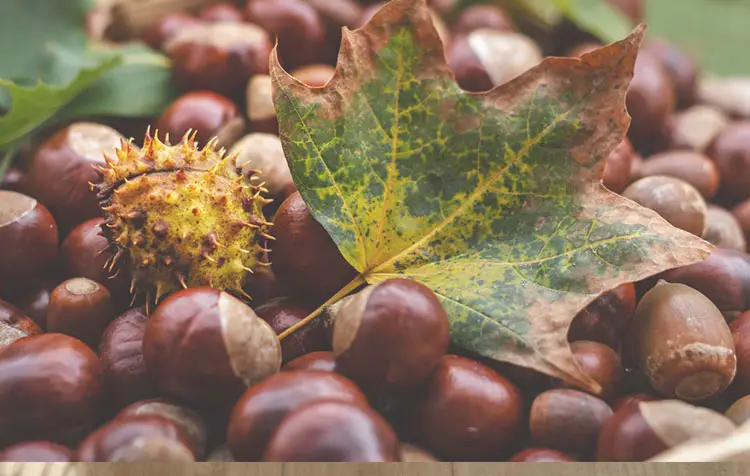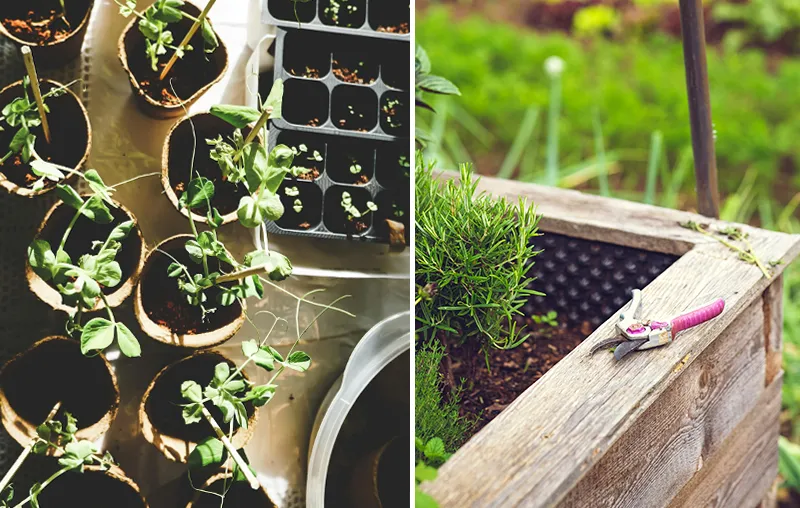Laundry can also be done without waste. And it's wonderfully sustainable. The large amount of detergent packaging causes Plastic waste without end. You can wash your laundry sustainably with very simple means and ensure that you leave behind less plastic waste. I'll show you how you can Make detergent yourself can. In the end, I also have a really strong alternative to homemade detergent for you!
Make your own washing powder - here's how
I think the coolest thing is the homemade detergent made from chestnuts! I'm sure some people will be surprised at how easy it is and how wonderfully the natural detergent works. But you can also make your own detergent from curd soap. You will now find brief instructions on how to do this!
Make detergent yourself from chestnuts
September/October is chestnut season! It was so cool to collect chestnuts back then! As you can use them to make your own washing powder, it's now a good reason for adults to go chestnut hunting again! Like ivy, chestnuts contain a lot of saponins, which produce foam and a soap-like liquid in water.
What you need:
- 500 ml container with lid / or a reused detergent bottle
- about 10 chestnuts (collect in autumn and stock up right away!)
- 300-400 ml water
- Kitchen sieve (This set* is ideal)
- Kitchen knife (This kitchen knife* is perfect, but you probably already have one in the kitchen!)
And this is how it works:
- Quarter chestnuts with a knife
- Add to your glass with 300-400 ml of water
- Wait about half a day (put the jar in the light).
- Sieve the resulting liquid
- Application in the detergent compartment of the washing machine
You will notice how it foams when you shake it. Try to shake the detergent vigorously once before each use. After using the homemade chestnut detergent, your laundry will not smell of anything, as we have not added any aromas or fragrances. But that can be freely varied. Chestnuts therefore offer the ideal opportunity to make your own laundry detergent. I recommend that you make proper provisions next fall so that you can make your own detergent for a long time to come. Incidentally, as well as being a washing powder, the liquid is also suitable for other cleaning tasks and as a dishwashing liquid. Try it out!
Make your own detergent from curd soap
Similar to the Homemade washing-up liquid, you can create a plastic free vegetable soap You can also grate it to make your own detergent. So you don't need much for this detergent either!
What you need:
- Large pot and several bottles or a large container (This pot* is ideal because it is very high)
- Kitchen grater (This kitchen grater* has four different sides)
- Kitchen knife (you should have one!)
- 30 g curd soap (This curd soap* is packed without plastic)
- 4 tablespoons washing soda (Here you can buy washing soda* - Really get some more right away! Alternatively you can get here 500g*)
- 3 drops of essential oil (e.g. this oil*. Basically, however, depending on the desired fragrance)
- 700 ml water
And this is how it works:
- Grate curd soap or cut into very small pieces
- Put water, washing soda and curd soap in a pot
- Stir vigorously (CAUTION: if the pan is shallow, it can quickly foam over)
- Turn on the stove and let the liquid boil
- Add essential oil (after cooling for about a quarter of an hour!)
- Fill the finished detergent into the desired container
Here too, you should shake the detergent vigorously before each use. Unlike chestnut laundry detergent, you can make your own laundry detergent all year round. If you always have chestnuts in stock, you can of course also make chestnut laundry detergent yourself at any time. To use the laundry detergent made from chestnut soap, you should use around 200 ml of the liquid you have made yourself.
Soapnuts - the alternative to homemade detergent
You can make your own detergent, but you can also use another natural product to wash your laundry clean. Soap nuts or the soap tree on which the nuts hang grow in tropical regions. In countries such as India, soap nuts have been used to clean laundry for many centuries. Like chestnuts and ivy, soap nuts also contain many saponins that produce foam. Unlike chestnuts, soap nuts are available all year round. Here you can order them plastic free*. Programs like Galileo have already tested them. The soap nuts clean better than conventional detergents, cost only half as much in the end and are environmentally friendly. They can be used more often and put in the organic waste garbage can after use. No plastic waste is produced and no complex manufacturing process is necessary. I have already tried the soap nuts and think they are really strong.
What you need:
- soap nuts (I use these soap nuts!*)
How to use the soap nuts:
- Take 5-7 half shells of the soap nuts
- Simply place the soap nuts in a small bag (or sock) with the laundry in the washing drum
More information about washing with soap nuts:
- The soap nuts can be used several times. (up to 5 times at low temperatures, up to 3 times at high temperatures)
- The naturally mild substances in soap nuts are suitable for all types of washing
- The soap nuts do not produce a fragrance during washing. You can add a few drops of essential oil* put in the fabric softener compartment of the washing machine
- The soap nuts can also be used for hair and are also suitable as a washing-up liquid, for making liquid soap or for cleaning cars
You can order the soap nuts directly here and try them out!*
Make your own detergent or use soap nuts
As you can see, you can do your laundry without plastic waste by making your own detergent or replacing it with soap nuts. Natural & plastic-free. Plasticfree lifestyle without waste is really easy. It can be so easy if we think outside the box and choose the environmentally conscious and sustainable way. Have fun doing your laundry! Feel free to write me a comment or a message with your experiences.
Best regards,

PS: You can also make your own washing-up liquid. Read the article Make your own washing-up liquid through. Have fun!







Really cool site, the detergent and toothpaste I will try. Shower gel from curd soap I already make myself.....nähe for friend and me fabric bags for shopping from old clothes and fabric scraps....
Got many more motivational ideas.....and would appreciate a deodorant recipe
many greetings Bianka
Hi Bianka! Thanks for the tip, "make your own deodorant" is on the list 🙂 Cool! Everyone should do that!
Many greetings
Christoph
Hello Christoph!
Great, your tips for environmentally friendly washing!
You're right, soap nuts really do wash great. Nevertheless, I would not recommend soap nuts, because since more and more Europeans have discovered soap nuts for themselves, the people in the countries of origin can no longer afford soap nuts. The prices for them have risen so much that, for example in India, almost exclusively chemical detergents are used. Wastewater is often discharged directly into rivers. For this reason, soap nuts are better avoided. With chestnuts or ivy you can but super class regional wash so to speak 😉
All the love, Marion
Hello Marion! Absolutely right! It's the same with all natural and seemingly sustainable things that don't grow in our country. The soap nuts would be ideal if the great demand from us in the country of origin would not cause such damage. That's why I also prefer chestnuts and ivy. They grow here in every village and do no harm in other countries.
Many greetings,
Christoph
Hello, Christoph!
I know since HOBBYTHEK and Jean Pütz no better alternatives to natural selnstgemachten Waschmiirötn. Since 1991 I use curd soap, beinSpinnrad buy och my essential oils and I have never regretted a day that I invent or replace detergents with natural products. Go on, that also the coming generations have something from mother earth and not a destroyed world, as it is implemented m.E. still in the policy too late. I am older, but my daughters find it great that I act environmentally friendly. I have the nature since my school time in the view and it is spitze that over the www so many ideas can be recommended also regiongerecht. Great praise!!!
The idea with ivy and the chestnuts is great, does it also work with dried chestnuts?
And what else is important,
When will people realize that you can't eat money...?
It's 5before12 and no one wants to admit it. LG, Chris
Hi Chris,
wow! Thanks for your great feedback, that makes us very happy! Regarding your question, yes, you can make your detergent with dried chestnuts. Just collect a few more in stock 🙂 Since they are a bit harder, the cutting is very difficult. But then the hammer helps 😉.
Best regards
Christoph
This is really interesting, You are an excessively professional blogger. I have joined your feed and look forward to in the hunt for more of your great post. Additionally, I have shared your website in my social networks!
Thanks for your feedback and effort! Happy to have you here 🙂
Cheers, Christoph
Hello Christoph,
I think your site is really great. However, it is often not easy to get something without plastic packaging. Some comparable, whether food or commodity, is often more expensive. With family sometimes not quite feasible. But I try it where it only goes.
I find the tip with the soap nuts very good. I've been using soap nuts myself for a short time. However, I still need to find something against grass, fruit, grease stains. Because these do not go out with the nuts. At Alnatura there are these nuts, unfortunately with plastic windows. Therefore, I looked at the same link here above. But even here you get the nuts not plastic-free.
Here is an excerpt from the reviews:
"One point deduction for unnecessary plastic in the packaging. The nuts are in the cloth bag again packed in a plastic bag. And since it was a double package (2×1 kg) were the two cloth bags again sealed in a larger plastic bag. Since a piece of string would also have been enough...."
Best regards and thanks for all the helpful tips.
Jasmine
Hi Jasmin,
thank you for your detailed feedback and the tip about the washing nuts! I have the manufacturer directly pointed out and hope that it will soon be adjusted 🙂
Stay clean,
Christoph
Hello Christoph,
I am thrilled with all your super ideas and try all possible! 100000 Thanks that you provide so many wonderful options here for free.
I would be interested to know if you can use the chestnuts again after you have prepared the broth once or if you can only prepare them once. Can you leave them longer in the water or should you leave them only one day in the water.
I would still be interested in how long you can store the chestnuts (they dry logically with time, is it the same for the detergent or should you then take something more)?
Am very grateful to you for this super page 🙂
Love greetings
Anna
Hi Anna! Thank you for your great feedback - we are very happy about that 🙂 .
Use 2x unfortunately does not work with the chestnuts. You should also cut the chestnuts as small as possible, so that the foaming ingredients also dissolve - with a second use it foams hardly.
You can store chestnuts forever! Just collect a big bag full in the fall, then you have long long peace 🙂
Stay clean,
Christoph
Hi Christoph, I have used soap nuts for many years for most laundry with success. However, as someone already described, for many stains (children: fruit, grass, grease ...) you need something extra to get them out. Also, my experience has been that white laundry is no longer white over time. The ecological bleaches I found required 90 degrees washing temperature and therefore were not suitable for all laundry. Do you have any tips for this as well? I assume this problem will also exist when using horse chestnut.
Thanks a lot
Love greetings
Monika
Hi Monika, thanks for your comment. I still wash with my washing nuts, which I have had for half an eternity - smell and color are always okay. So blatant stains I have not yet had - can someone else help?
Many greetings,
Christoph
Hello,
These are super ideas. I year by chance still many now dried chestnuts that my daughter has collected in the fall. I'll try it out right away. How much of the detergent do I take afterwards per wash load?
Warm regards
Hi Marit! Since you can just take the usual amount - always depends on the mass of laundry 🙂
Many greetings
Christoph
Hello Christoph,
Thank you very much for your answer.
I have prepared the first brew. ? my question now is, how long does the finished detergent keep, so how quickly should I consume it?
And do you still put essential oils in it or have a recommendation for that?
Warm regards
Marit
Hi Marit! Great, what kind of detergent did you do? Basically, you can expect it to keep for about 2-5 weeks 🙂
Many greetings
Christoph
I also use chestnut detergent for washing cars. My colleague relies on vinegar for washing. I must say that I like washing with chestnuts better, not only for the car.
Hi Emma, cool example! Must I also try out 😉
Many greetings
Christoph
Hello,
it must not always be curd soap. Aleppo soap / olive oil soap is also super good for washing! 🙂 Supposedly leaves the eventually a gray haze, but I have seen nothing after a year of washing with it.
LG
Hello Julia!
You are absolutely right, I also have Aleppo soap here with me and have also not noticed anything of a possible gray haze.
Stay clean,
Christoph
Do you always have to prepare the detergent fresh or does a batch keep for a while?
LG
ANTJE
Hi Antje! That always depends on how much you make. But basically you can use it for a few weeks. As with food, it is also true for homemade detergent to trust your own senses.
Best regards
Christoph